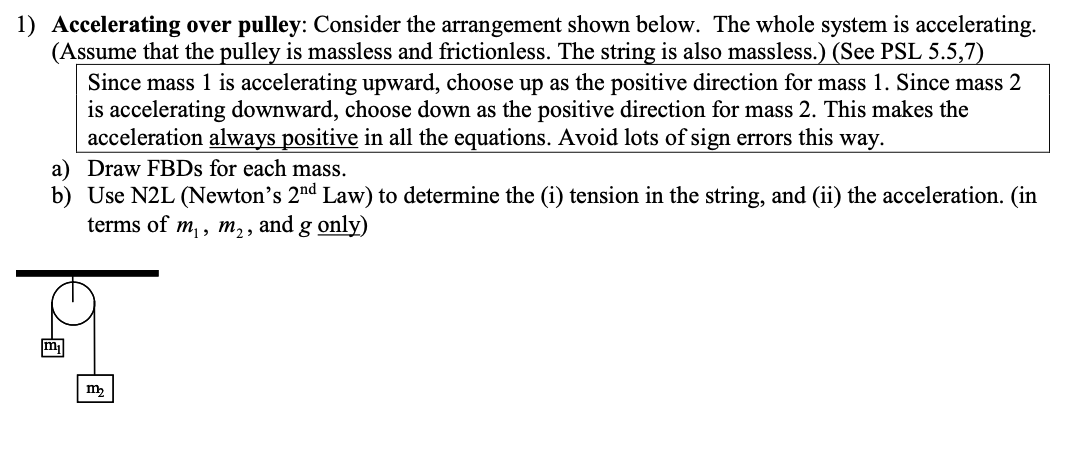1) Accelerating over pulley: Consider the arrangement shown below. The whole system is accelerating. (Assume that the pulley is massless and frictionless. The string is also massless.) (See PSL 5.5,7) Since mass 1 is accelerating upward, choose up as the positive direction for mass 1. Since mass 2 is accelerating downward, choose down as the positive direction for mass 2. This makes the acceleration always positive in all the equations. Avoid lots of sign errors this way. a) Draw FBDs for each mass. b) Use N2L (Newton's 2nd Law) to determine the (i) tension in the string, and (ii) the acceleration. (in terms of m₁, m₂, and g only) m₂
1) Accelerating over pulley: Consider the arrangement shown below. The whole system is accelerating. (Assume that the pulley is massless and frictionless. The string is also massless.) (See PSL 5.5,7) Since mass 1 is accelerating upward, choose up as the positive direction for mass 1. Since mass 2 is accelerating downward, choose down as the positive direction for mass 2. This makes the acceleration always positive in all the equations. Avoid lots of sign errors this way. a) Draw FBDs for each mass. b) Use N2L (Newton's 2nd Law) to determine the (i) tension in the string, and (ii) the acceleration. (in terms of m₁, m₂, and g only) m₂
Physics for Scientists and Engineers, Technology Update (No access codes included)
9th Edition
ISBN:9781305116399
Author:Raymond A. Serway, John W. Jewett
Publisher:Raymond A. Serway, John W. Jewett
Chapter5: The Laws Of Motion
Section: Chapter Questions
Problem 5.88AP: Consider the three connected objects shown in Figure P5.88. Assume first that the inclined plane is...
Related questions
Topic Video
Question

Transcribed Image Text:1) Accelerating over pulley: Consider the arrangement shown below. The whole system is accelerating.
(Assume that the pulley is massless and frictionless. The string is also massless.) (See PSL 5.5,7)
Since mass 1 is accelerating upward, choose up as the positive direction for mass 1. Since mass 2
is accelerating downward, choose down as the positive direction for mass 2. This makes the
acceleration always positive in all the equations. Avoid lots of sign errors this way.
a) Draw FBDs for each mass.
b) Use N2L (Newton's 2nd Law) to determine the (i) tension in the string, and (ii) the acceleration. (in
terms of m₁, m₂, and
g only)
m₂
Expert Solution
This question has been solved!
Explore an expertly crafted, step-by-step solution for a thorough understanding of key concepts.
Step by step
Solved in 3 steps with 3 images

Knowledge Booster
Learn more about
Need a deep-dive on the concept behind this application? Look no further. Learn more about this topic, physics and related others by exploring similar questions and additional content below.Recommended textbooks for you

Physics for Scientists and Engineers, Technology …
Physics
ISBN:
9781305116399
Author:
Raymond A. Serway, John W. Jewett
Publisher:
Cengage Learning

Physics for Scientists and Engineers: Foundations…
Physics
ISBN:
9781133939146
Author:
Katz, Debora M.
Publisher:
Cengage Learning

College Physics
Physics
ISBN:
9781285737027
Author:
Raymond A. Serway, Chris Vuille
Publisher:
Cengage Learning

Physics for Scientists and Engineers, Technology …
Physics
ISBN:
9781305116399
Author:
Raymond A. Serway, John W. Jewett
Publisher:
Cengage Learning

Physics for Scientists and Engineers: Foundations…
Physics
ISBN:
9781133939146
Author:
Katz, Debora M.
Publisher:
Cengage Learning

College Physics
Physics
ISBN:
9781285737027
Author:
Raymond A. Serway, Chris Vuille
Publisher:
Cengage Learning

College Physics
Physics
ISBN:
9781305952300
Author:
Raymond A. Serway, Chris Vuille
Publisher:
Cengage Learning

Principles of Physics: A Calculus-Based Text
Physics
ISBN:
9781133104261
Author:
Raymond A. Serway, John W. Jewett
Publisher:
Cengage Learning

College Physics
Physics
ISBN:
9781938168000
Author:
Paul Peter Urone, Roger Hinrichs
Publisher:
OpenStax College